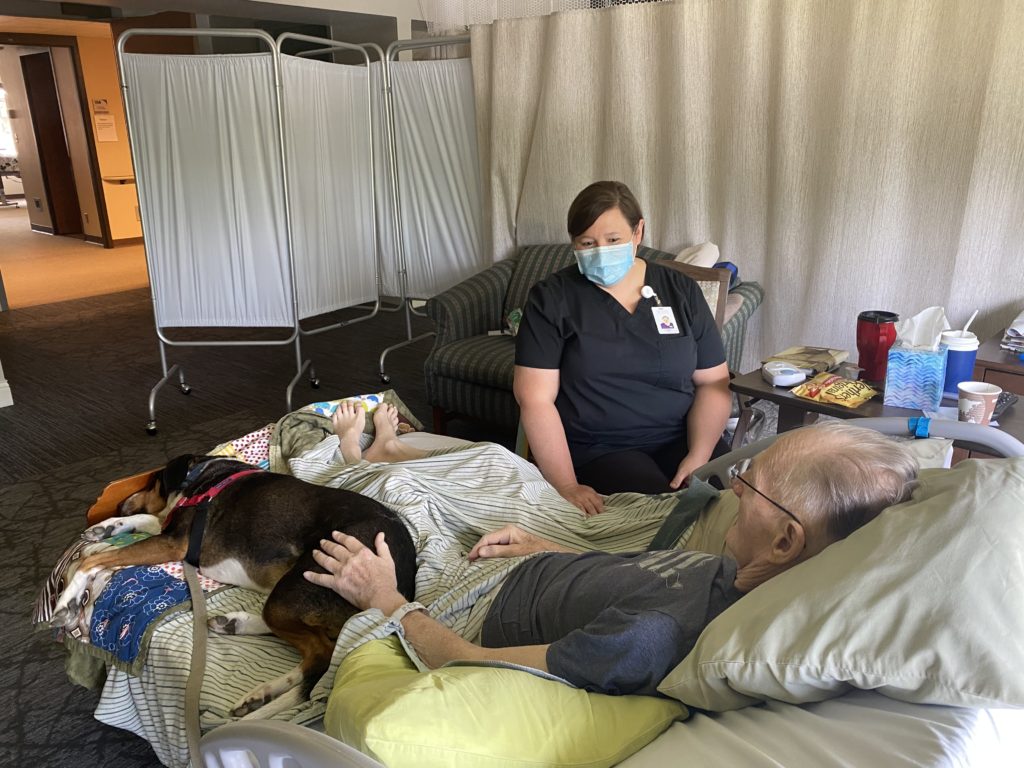There are four levels of hospice care: Routine Home Care (RHC), Continuous Home Care (CHC), Inpatient Respite Care (IRC), and General Inpatient Hospice Care (GIP). Our Lady of Peace (OLP) Hospice Medical Director Michael Pinchback, MD, HMDC and Nurse Lindsey Pelletier, RN, BSN, CHPN, our performance improvement coordinator, recently spoke at the 2022 Minnesota Network of Hospice & Palliative Care (MNHPC)’s Annual Conference. We want to share some of the highlights of their presentation here that you may find helpful when navigating through hospice care.
GIP may be provided in a Medicare participating hospital, skilled nursing facility (SNF), or hospice inpatient facility. The Our Lady of Peace (OLP) Hospice Residence is a Medicare certified hospice facility with 24-hour nursing care. Categorized as GIP, we offer short-term care that provides pain and symptom management and stabilizing treatment that can’t be accomplished in another setting. The average typical stay in the OLP Hospice Residence is five days. All in-home hospice organizations are required to hold a contract with a GIP provider. In addition to our own in-home hospice program, we hold contracts with other hospices.
There is no specified disease, condition, or symptom that qualifies a patient to receive GIP hospice care. it’s not automatic when a patient is imminently dying, it isn’t intended to address unsafe living conditions or provide caregiver respite. Appropriate use of GIP includes a patient in need of medication adjustment, observation, or other stabilizing treatment and is initiated when other efforts to control symptoms are ineffective.
Here are a couple examples
- 80-year-old Nancy was diagnosed with Parkinson’s disease five years ago and was receiving a routine level of hospice care in her own home. After two months in hospice care, she was admitted to OLP for pain management for chronic low back pain. Dr. Pinchback and his team got Nancy’s pain under control with medication, and she returned home to a routine level of care.
- 42-year-old Kathy was diagnosed with Invasive Ductal Carcinoma four years ago. An emergency room visit earlier in the year for “bizarre behavior” had revealed her cancer was determined to be in recurrence with metastases to the brain and bone.
Given the rapid progression of the disease, Kathy’s decline, and her lack of interest in further heroic interventions, hospice was elected, and Kathy was admitted to our hospice residence. Within a few days, her pain was controlled, and she became more comfortable. However, she began calling her daughters in the middle of the night, asking them why she had to suffer and “Where is God?” causing distress for them.
She also experienced an increase in agitation, confusion, and frightening hallucinations, but our staff was able to provide medications to treat it and make Kathy comfortable again, with the help of continued intensive social work and chaplain involvement. Her family was happy that she was “suffering less.” Kathy passed away in our care.
After over 80-years of providing hospice care, we have many stories to share, rooted in our mission of providing the highest quality of life for hospice patients. Some come in and leave our care, and some remain and pass in our care.
We hope that by sharing these stories and the knowledge of our medical team, we give you a better understanding of the qualifications and benefits of general inpatient hospice care. We are grateful for Dr. Pinchback, Nurse Lindsey Pelletier, and our entire hospice team for the care they provide to OLP patients and families.
The general inpatient information shared within this blog is excerpted from the MNHPC presentation by Dr. Pinchback and Lindsey Pelletier, RN on September 29, 2022.
